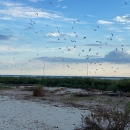The Lower Great Lakes Fish and Wildlife Conservation Office maintains an advanced geospatial services program for the support of on-going fisheries and habitat restoration activities. The program is the combination of hardware, software, data, people, and techniques used to better understand the patterns and relationships of spatial, biological, and physical information. Geospatial services are tools resource managers can use to visually identify spatial patterns that might not otherwise be apparent.
The office uses geospatial capabilities to identify important habitats for native species, define areas to survey for invasive species invasive species
An invasive species is any plant or animal that has spread or been introduced into a new area where they are, or could, cause harm to the environment, economy, or human, animal, or plant health. Their unwelcome presence can destroy ecosystems and cost millions of dollars.
Learn more about invasive species , determine location and movement patterns, link biological and physical information, and recognize spatial patterns. These capabilities allow us to look at our data in new ways providing managers with a visual understanding and interpretation of biological and physical information.




